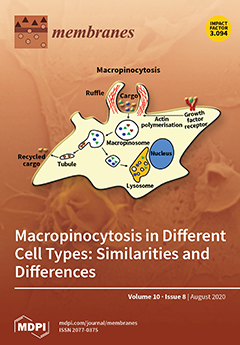In this work, the behavior of new GO-based mixed matrix membranes was tested in view of their use as CO
2-selective membrane in post combustion carbon capture applications. In particular, the new materials were obtained by mixing of Pebax
® 2533 copolymer
[...] Read more.
In this work, the behavior of new GO-based mixed matrix membranes was tested in view of their use as CO
2-selective membrane in post combustion carbon capture applications. In particular, the new materials were obtained by mixing of Pebax
® 2533 copolymer with different types of graphene oxide (GO). Pebax
® 2533 has indeed lower selectivity, but higher permeability than Pebax
® 1657, which is more commonly used for membranes, and it could therefore benefit from the addition of GO, which is endowed with very high selectivity of CO
2 with respect to nitrogen. The mixed matrix membranes were obtained by adding different amounts of GO, from 0.02 to 1% by weight, to the commercial block copolymers. Porous graphene oxide (PGO) and GO functionalized with polyetheramine (PEAGO) were also considered in composites produced with similar procedure, with a loading of 0.02%wt. The obtained films were then characterized by using SEM, DSC, XPS analysis and permeability experiments. In particular, permeation tests with pure CO
2 and N
2 at 35°C and 1 bar of upstream pressure were conducted for the different materials to evaluate their separation performance. It has been discovered that adding these GO-based nanofillers to Pebax
® 2533 matrix does not improve the ideal selectivity of the material, but it allows to increase CO
2 permeability when a low filler content, not higher than 0.02 wt%, is considered. Among the different types of GO, then, porous GO seems the most promising as it shows CO
2 permeability in the order of 400 barrer (with an increase of about 10% with respect to the unloaded block copolymer), obtained without reducing the CO
2/N
2 selectivity of the materials, which remained in the order of 25.
Full article






